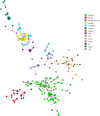Tuberculous Lymphadenitis in Ethiopia Predominantly Caused by Strains Belonging to the Delhi/CAS Lineage and Newly Identified Ethiopian Clades of the Mycobacterium tuberculosis Complex
- PMID: 26376441
- PMCID: PMC4573740
- DOI: 10.1371/journal.pone.0137865
Tuberculous Lymphadenitis in Ethiopia Predominantly Caused by Strains Belonging to the Delhi/CAS Lineage and Newly Identified Ethiopian Clades of the Mycobacterium tuberculosis Complex
Abstract
Background: Recently, newly defined clades of Mycobacterium tuberculosis complex (MTBC) strains, namely Ethiopia 1-3 and Ethiopia H37Rv-like strains, and other clades associated with pulmonary TB (PTB) were identified in Ethiopia. In this study, we investigated whether these new strain types exhibit an increased ability to cause TB lymphadenitis (TBLN) and raised the question, if particular MTBC strains derived from TBLN patients in northern Ethiopia are genetically adapted to their local hosts and/or to the TBLN.
Methods: Genotyping of 196 MTBC strains isolated from TBLN patients was performed by spoligotyping and 24-loci mycobacterial interspersed repetitive unit-variable number of tandem repeats (MIRU-VNTR) typing. A statistical analysis was carried out to see possible associations between patient characteristics and phylogenetic MTBC strain classification.
Results: Among 196 isolates, the majority of strains belonged to the Delhi/CAS (38.8%) lineage, followed by Ethiopia 1 (9.7%), Ethiopia 3 (8.7%), Ethiopia H37RV-like (8.2%), Ethiopia 2 and Haarlem (7.7% each), URAL (3.6%), Uganda l and LAM (2% each), S-type (1.5%), X-type (1%), and 0.5% isolates of TUR, EAI, and Beijing genotype, respectively. Overall, 15 strains (7.7%) could not be allocated to a previously described phylogenetic lineage. The distribution of MTBC lineages is similar to that found in studies of PTB samples. The cluster rate (35%) in this study is significantly lower (P = 0.035) compared to 45% in the study of PTB in northwestern Ethiopia.
Conclusion: In the studied area, lymph node samples are dominated by Dehli/CAS genotype strains and strains of largely not yet defined clades based on MIRU-VNTR 24-loci nomenclature. We found no indication that strains of particular genotypes are specifically associated with TBLN. However, a detailed analysis of specific genetic variants of the locally contained Ethiopian clades by whole genome sequencing may reveal new insights into the host-pathogen co-evolution and specific features that are related to the local host immune system.
Conflict of interest statement
Figures


Similar articles
-
The predominance of Ethiopian specific Mycobacterium tuberculosis families and minimal contribution of Mycobacterium bovis in tuberculous lymphadenitis patients in Southwest Ethiopia.Infect Genet Evol. 2017 Nov;55:251-259. doi: 10.1016/j.meegid.2017.09.016. Epub 2017 Sep 15. Infect Genet Evol. 2017. PMID: 28919549
-
Genetic Diversity of Mycobacterium tuberculosis Isolates from Assam, India: Dominance of Beijing Family and Discovery of Two New Clades Related to CAS1_Delhi and EAI Family Based on Spoligotyping and MIRU-VNTR Typing.PLoS One. 2015 Dec 23;10(12):e0145860. doi: 10.1371/journal.pone.0145860. eCollection 2015. PLoS One. 2015. PMID: 26701129 Free PMC article.
-
Molecular epidemiology of clinical Mycobacterium tuberculosis complex isolates in South Omo, Southern Ethiopia.BMC Infect Dis. 2020 Oct 13;20(1):750. doi: 10.1186/s12879-020-05394-9. BMC Infect Dis. 2020. PMID: 33050903 Free PMC article.
-
[New era in molecular epidemiology of tuberculosis in Japan].Kekkaku. 2006 Nov;81(11):693-707. Kekkaku. 2006. PMID: 17154049 Review. Japanese.
-
Genomic diversity and transmission dynamics of M. tuberculosis in Africa: a systematic review and meta-analysis.Int J Tuberc Lung Dis. 2019 Dec 1;23(12):1314-1326. doi: 10.5588/ijtld.19.0127. Int J Tuberc Lung Dis. 2019. PMID: 31931916
Cited by
-
Molecular typing of mycobacteria isolated from tuberculous lymphadenitis cases in Addis Ababa, Ethiopia.Int J Tuberc Lung Dis. 2016 Nov;20(11):1529-1534. doi: 10.5588/ijtld.15.1023. Int J Tuberc Lung Dis. 2016. PMID: 27776596 Free PMC article.
-
Drug Resistance Conferring Mutation and Genetic Diversity of Mycobacterium tuberculosis Isolates in Tuberculosis Lymphadenitis Patients; Ethiopia.Infect Drug Resist. 2021 Feb 15;14:575-584. doi: 10.2147/IDR.S298683. eCollection 2021. Infect Drug Resist. 2021. PMID: 33623398 Free PMC article.
-
Comparative whole-genome sequence analysis of Mycobacterium tuberculosis isolated from pulmonary tuberculosis and tuberculous lymphadenitis patients in Northwest Ethiopia.Front Microbiol. 2023 Jun 30;14:1211267. doi: 10.3389/fmicb.2023.1211267. eCollection 2023. Front Microbiol. 2023. PMID: 37455714 Free PMC article.
-
Demographic risk factors for extra-pulmonary tuberculosis among adolescents and adults in Saudi Arabia.PLoS One. 2019 Mar 27;14(3):e0213846. doi: 10.1371/journal.pone.0213846. eCollection 2019. PLoS One. 2019. PMID: 30917151 Free PMC article.
-
Microbead-based spoligotyping of Mycobacterium tuberculosis from Ziehl-Neelsen-stained microscopy preparations in Ethiopia.Sci Rep. 2018 Mar 5;8(1):3987. doi: 10.1038/s41598-018-22071-9. Sci Rep. 2018. PMID: 29507363 Free PMC article.
References
-
- World Health Organization. Global Tuberculosis control (2013) World Health Organization Geneva, WHO. Available: http://www.who.int/tb/data.
-
- World Health Organization. Global tuberculosis control (2011) World Health Organization, Geneva, WHO. Available: http://whqlibdoc.who.int/publications/2011/9789241564380_eng.pdf.
-
- World Health Organization. Global Tuberculosis Control (2010) Surveillance, planning, Financing. World Health Organization, Geneva, WHO.WHO/HTM/TB/2010.
-
- Federal Ministry of Health of Ethiopia (2009) Guideline for program and clinical management of drug resistant tuberculosis 1st ed. Addis Ababa, Ethiopia: FMOH; Available: http://www.etharc.org/resources/download/finish/66/367.
Publication types
MeSH terms
Substances
LinkOut - more resources
Full Text Sources
Other Literature Sources

